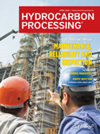December 2004
Plant Safety and Environment
Safeguarding system interactions: a case study
A custom made PHA methodology can help find hidden problems in your facility

 COPYING AND DISTRIBUTING ARE PROHIBITED WITHOUT PERMISSION OF THE PUBLISHER
COPYING AND DISTRIBUTING ARE PROHIBITED WITHOUT PERMISSION OF THE PUBLISHER
A custom made PHA methodology can help find hidden problems in your facility

Comments